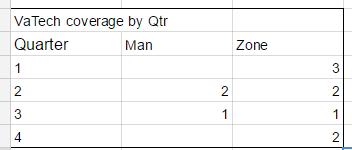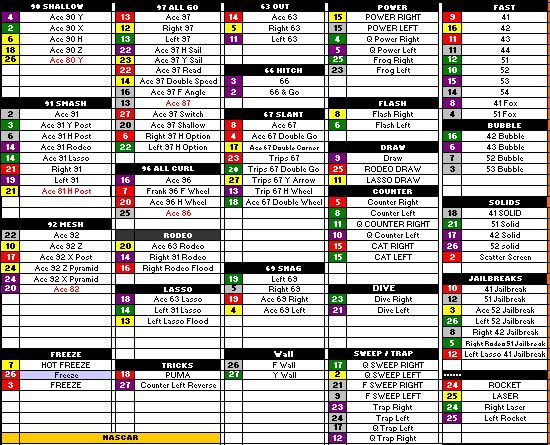Much has been said about the playcalling in the second half of the game, specifically how Brian Kelly either called a particularly bad second half or failed to adjust to Virginia Tech’s adjustments. In this post I will attempt to investigate several of these assertions and see which have merit.
Methodology
I have often found that the easiest stats to obtain for a football game are almost always the least descriptive and misleading. Today, a Run/Pass option throw is stated as a passing play, regardless if it was a 0 yard throw and despite the fact that it was a called run play. On the other hand, Notre Dame’s Jet Sweep “run” play is stated as a pass. Additionally, many wish to judge an offense on run/pass balance but this stat completely disregards the defense: a team could load 11 in the box and the offense throw every play and because of that they are a “pass happy team”. Or a defense could have a 4 man box vs an air raid team, and that team would be considered “run heavy” for that game.
Instead, I took it upon myself to try to produce some more useful stats: I have charted every offensive play from the Virginia Tech game (And many of our other games, but that will be used sometime later).
So several general ideas. First, an offense should generally run the ball on standard situations when given favorable numbers. Second, it is difficult (in that it is unfair) to judge a playcaller on passing downs as the defense pretty much knows what is going to come.
Offensive Adjustments
Brian Kelly’s offense is not best described as run heavy or pass heavy but rather flexible balanced spread: when the numbers are favorable he runs a bit more than he throws, and when the numbers are not he throws a lot more often than he runs.
His offense is built on certain fundamental ideas about how the defense can align/react and certain concepts/plays that take advantage of the different reactions. This is what is known as a base offense. Within the offense there are constraint plays that force the defense to play fair and there are concepts that punish a particular front or coverage. The base idea around BK’s offense is that it is generally better to take a offensive player out of the box, instead of adding another, in order to force the defense to spread out so that the offense can run.
One shouldn’t really adjust from a base offense, it was chosen because it has a mostly holistic answer to every possibility that a defense can throw in. A defensive adjustment might emphasize one player on offense being taken away, and a offensive adjustment could be to try to get that player back in the game (for example using a quads formation and isolating a receive 1×4 so he can’t be bracketed easily).
Into the stats
All of the following is based on standard downs in standard situations. Standard downs are defined as first downs, second and 6 or fewer, third and four or fewer and fourth and 4 or fewer, basically a standard down is when an offense can reasonably run or pass. I am specifically only using standard downs because it is the down where a playcaller has the least amount of restrictions. Also, passing downs versus a defense such as Virginia Tech (ranked 7th in passing S&P) is particularly devastating and failure on that down is more a symptom of failure on previous standard downs than playcalling. Standard situations I’m defining as non-blowout score differential and not the last 2 minutes of either half, both of these dramatically affect an offense’s playcalling and isn’t very suitable to derive a larger trend.
The first interesting stat that I found, is that Notre Dame did not run option runs that often. They ran 13 total option plays with 7 of them being in the first quarter. Virginia Tech initially did not handle the option well with 80% of the total game’s QB option runs being in the first quarter alone. I would say that Virginia did adjust to better take away the option keeps (telling the defensive end to stay) however Notre Dame simply went away from calling option plays on standard downs.
The second stat is something I call Box Differential, it represents how many more defenders than offenders are in the box. Tight ends, linemen, and one running back in a two running back set are counted as blockers. Basically the idea is that a pro-style run is favorable with a Box Differential of <=0 and an option run is favorable at <= +1 Box Differential. A pro-style run is basically any run that does not involve the quarterback in the run game, and an option run is the opposite. Box Differential 0 is even defenders and blockers and Box Differential +1 is one more defender than blocker. Box Differentials of -1 or +2 are pretty unusual for a standard situation, but Virginia Tech ran two more box defenders than the offense a significant amount in the first quarter.
In the first quarter Virginia Tech adjusted to being blasted on the ground by stacking the box to Box Differential +2, and in the second quarter consistently kept one more defender than Notre Dame could block without using Kizer in the running game. In the second half Notre Dame was basically dared to run the ball on standard downs even without having to subject DeShone to the possibility of a hit.
The following is Notre Dame’s called run/pass % versus quarter. The first chart is how Notre Dame chose to run versus even box blockers and defenders where any pro-style run would be favorable, and the second is where any option/qb run would be favorable. For my purposes, an RPO is always counted as a called run, and a jet sweep is counted as a run.

Brian Kelly chose running plays a large percent of the time during the first quarter against both even and +1 Box Differential. The second quarter it appears that Notre Dame did not run much at all, but it was more because Notre Dame ran several playaction passes instead of runs on standard downs to take advantage of the first quarter’s running success. The third quarter was slanted a bit toward running with 71% of the standard downs being running plays. The fourth quarter is slanted by small sample size with 5 standard situation downs with two runs, one each of a screen, playaction and standard pass.
Did Virginia Tech adjust versus the pass throughout the game?
The following is the pass rushes vs Notre Dame quick passes, standard passes, or playaction passes. Quick passes are defined to be 3 step drop, and a standard pass is a 5 or 7 step drop. There were 11 total standard situation quick, standard or play action passes. Of them there was no real correlation to quarter of blitz percent. Additionally Va Tech mostly used zone, and again there was no real correlation to quarter. In short, Virginia Tech did not really adjust versus Notre Dame’s passing plays on standard situations throughout the game.


These are the numbers of Notre Dame run,pass success and failures on standard situations versus quarters. Success is defined as gaining 50% of the needed yards on first down, 70% of the yards on second down, and obviously 100% of the yards on third or fourth down. As you can see, the standard down runs in the third quarter were not very successful and Brian Kelly chose to pass on standard downs in the fourth quarter despite having the numbers to run comfortably. The fourth quarter passes were not successful at all and threw Kizer and the offense off standard downs for nearly the entire fourth quarter.

Conclusion
In my opinion, what happened the second half was two fold, Brian Kelly did not run as much as he should have based on the box numbers, especially option (which is more understandable considering how fantastic the referees were) and ND did not execute on standard down passes or runs in the second half. It is not unusual to pass when given even numbers to run, but a pass has a much greater variance than a run with even blockers. The unsuccessful runs and passes in the second half threw the offense off schedule and let everyone in the stadium know it is a passing down.
I do not believe that Brian Kelly’s playcalling was responsible for losing the game. However, Kelly is ultimately responsible for ensuring his team is able to execute properly, but with the wealth of reasons fans justly have to doubt Brian Kelly, we do not need to create any more out of areas they do not belong.
What do you think? Was I wrong? Is there more information needed? If you have any playcalling questions about the Va Tech game I’ll try to answer in the comments.
You can follow 18stripes on twitter at https://twitter.com/18stripes and me at https://twitter.com/Downinthebend .






From the non-cognoscenti press box — great stuff and thank you. The second quarter is maybe the one that interests me the most. This team has displayed this amazingly consistent inability to close out. I think it started in the 2nd quarter, and it would be interesting to look at the standard down calls after we went up 24-7.
Thanks! That is something I’m going to try to address in the offseason, what exactly happened when we built large lead. I haven’t looked into it too much, but it is going to be hard to measure aggressiveness when probably 90% of pass plays are difficult to diagram. I have a couple ideas but I’ll have to see how it works out.
Is it BK calling plays or is it Denbrock?
Whoever scripts our first 20 plays is the one who should have play calling duties. Wouldnt be surprised if its Sanford.
While BK may not be exactly calling every play it is probably safe to assume that he is heavily involved in the gameplanning and the macro game decisions. The script is also an interesting topic because aside from pace it seems generally (the games i’ve charted) similar to the rest of the game in formations/plays.
You are right.
I just hope he lets Coach Sanford do the job he was brought in for. BK said on Sunday that there will only be 1 OC in 2017. If its not Sanford we could lose him.